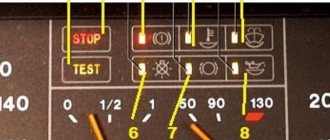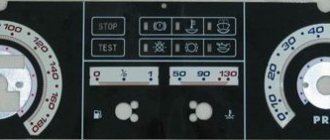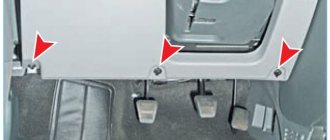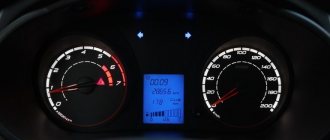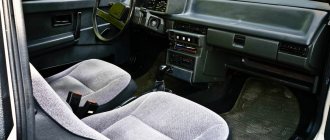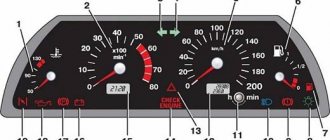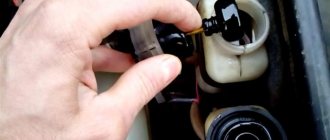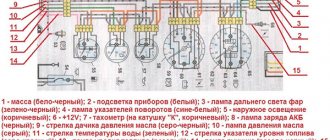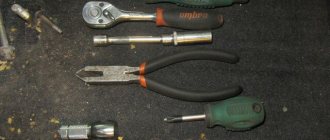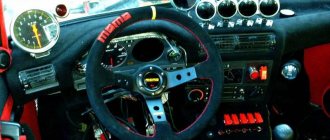In 1984, the first “eight”, the VAZ 2108, rolled off the assembly line of the AvtoVAZ concern, followed by the five-door “nine”, the VAZ 2109, in 1987. The difference was not only in the presence of a rear door for this line of cars. The designers changed the instrument panel of the VAZ 2109.
The shield turned out to be quite simple, so it is easy to understand. The devices are conveniently located, do not overlap each other, and the readings are easy to read. Initially, the dashboard had a standard rectangular shape with slightly rounded corners. Smoothed corners and familiar visors appeared much later. Three types of instrument panels were installed on the VAZ 2109 - “low”, “high” and Europanel.
Differences between “low” and “high” panels
Depending on what combination of instruments is installed in the “nine”, the type of car dashboard depends. According to car enthusiasts, the most successful was the first version of the car with a “low” panel. This dashboard was characterized by a convenient arrangement of instruments, the presence of a wide shelf on top and good air supply. Thanks to this, temperature changes in the cabin were not so dangerous and the windshield did not fog up. Serious disadvantages include the overly primitive appearance and the lack of a tachometer.
Low panel for VAZ 2109
The “high” version has a lot in common with the modern Europanel, which resembles the dashboard of an expensive foreign car. A lot of effort was invested in its creation, but car enthusiasts often complained about insufficient heating. But it is not the shield that is to blame, but the heater.
High instrument panel VAZ 2109
The “low” panel of the VAZ 2109 is in demand to this day. The shield is distinguished by the presence of a voltmeter. The speedometer has a total mileage counter at the top, and a daily mileage counter below it. The speedometer itself is located in the center. It is worth noting the location of the signal lamps for vehicle performance indicators - they are all arranged on the left side. This includes the oil pressure sensor, brake fluid level signal, dimensions, etc.
The “high” panel on the VAZ 2109 replaced the “low” one. It has both advantages and a number of serious disadvantages. For inexperienced car enthusiasts, the main distinguishing feature of the “high” panel is the presence of not only a speedometer, but also a tachometer. In this case, the speedometer is located on the left, and not in the center. In both tidy models, the speedometer is marked up to 180 km/h, but the power unit will not be able to accelerate the car to that speed (only at maximum speed and downhill). The fuel level and coolant temperature sensors in both versions have a classic arrow shape. There is no power to the tidy.
Of the two instrument panels of the VAZ 2109, car enthusiasts prefer the “low” one, since in cold weather it does not rattle, and the stove copes with its duties much better.
Which low panel or high panel is more suitable for the VAZ 2109?
Despite the fact that the VAZ-2108/2109 is already more than thirty years old, these cars can easily be found on our roads. And you can’t call them bad – they’re completely normal cars. As long as these cars have existed, there has been controversy surrounding their dashboards.
The fact is that there is a “low” panel and a “high” one. The low panel was on the first 08/09, and later, a high panel appeared, which replaced the low one, from about 1997.
And each option has its supporters. Some people remove the low panel and install a high one, while others bought a nine after 1997 and are looking for a Soviet low panel to replace the high one with.
“It’s a matter of taste,” you say, and I agree with that. Really, whatever you like. But low and high panels have their own objective pros and cons.
Many people don't like the look of a low panel, but these people either leave the low one or install it instead of the high one. Why is that? I was not interested in this topic at all because I was a passenger on a nine with both a high panel and a low one... in my opinion, both rattle. But I wanted to figure out where such disputes come from.
Low panel
The main advantage of a low panel is that the stove heats much better with it, and this is true. In 08/09 with a low panel it is really warm, which certainly cannot be said about a high panel. The ventilation itself is clever and the airflow is correct.
The low panel is stronger and less creaky. This is recognized by the owners of both low and high panels. As I wrote above, I was a passenger on nines with both panels, and so, although both creak, the low one is much less. There's just nothing particularly creaky there.
With a low panel, the interior appears visually larger. And this is also true. The low panel has plenty of room to put something on it. And if you don’t like it, you can buy a panel overlay and make a higher one from a low one.
But the most important disadvantage is that the low panel does not have a tachometer. But firstly, it is quite possible to do without it, and secondly, no one bothers you to install a separate tachometer.
High panel
One of the objective advantages is the presence of a tachometer. Also, on the high panel there is illumination of the glove compartment and buttons. There are places for additional buttons. It also looks more modern. But the main thing is that many people simply like it.
The stove is cooler on a high panel. This is due to the ventilation design itself. Due to the fact that there are more parts on a high panel, it creaks more, but this can be solved by gluing it with soundproofing materials.
Well, in general, if you change the panel, you can install it from a VAZ-2114. It fits in size because it is the same 08/09. Relatively not creaky, with normal airflow and a modern look. True, it is more difficult to redo the wiring there.
Today, VAZ 2109 cars that can be found on domestic roads, no matter whether they have carburetors or injectors, are equipped with three types of electronic devices. It can be a low panel, a high panel or a Europanel. Let's consider the description of each type separately.
Instrument cluster “Low” panel
Low version of the control panel
Let's start with the low option. A detailed explanation of the scheme is given in the table.
| Icon | Purpose |
| 32 | Indicates which turn signal is on. The indicator stops working after the steering wheel is turned. |
| 33 | A light lamp that turns on when the low beam is activated. |
| 34 | Lights up when the PTF - fog lights are turned on. |
| 35 | Lamp for turning on high beam headlights. |
| 36 | Notifies the driver that the rear window heating system is operating. |
| 37 | A signal alerting the motorist to the need to stop and repair a fault. |
| 38 | Speedometer. |
| 39 | A counter that records the daily mileage of a vehicle. |
| 40 | A sensor that notifies the driver about the temperature of the antifreeze in the cooling system. |
| 41 | A sensor that records the voltage level in the vehicle's on-board network. |
| 42 | An icon that lights up when the engine fluid pressure in the system is too low. |
| 43 | hazard warning lamp. |
| 44 | The diode lights up if the brake system is in emergency condition. |
| 45 | Icon for turning on the carburetor choke or choke. |
| 46 | Engaging the handbrake. |
| 47 | This element appears when the car battery is low charged. |
| 48 | Vehicle mileage counter. |
| 49 | An ecometer whose needle rises when you press the gas pedal. |
| 50 | A line that is not recommended to be crossed - the light starts to light when the gasoline level is critically low. |
| 51 | Sensor for measuring fuel level in the tank. |
Instrument cluster “High” panel
Instrument cluster on high panel
Below is a high-type VAZ 2109 instrument panel with electronic backlight. Relevant for both injectors and carburetors. You will find a decoding of the circuit and combinations according to the instructions below.
| Icon | Designation |
| 42 | Speedometer, which displays the speed of the car. |
| 43 | An odometer that records the mileage of a vehicle. |
| 44 | Sensor for measuring fuel level in the tank. |
| 45 | A signal alerting the motorist to the need to stop and repair a fault. |
| 46 | Test lamp. |
| 47 | A signal alerting the motorist to the need to stop and repair a fault. |
| 48 | Lamp warning the driver about a malfunction in the operation of the signal lights. |
| 49 | A sensor that notifies the driver of a lack of antifreeze in the cooling system. |
| 50 | An indicator indicating wear of the brake pads on the front wheels. |
| 51 | The light comes on to warn the motorist about the lack of fluid in the windshield and rear window washer reservoir. |
| 52 | Indicator of lack of engine fluid pressure in the crankcase. |
| 53 | The regulator measures the antifreeze temperature level in the cooling system and displays this data on an electronic panel with backlight. |
| 54 | This icon on the high combination of the dashboard is a tachometer, demonstrating the level of engine speed of the car. |
| 55 | Additional socket. |
| 56 | A button designed to reset the daily mileage. |
| 57 | A lamp that lights up when the car's headlights are turned on. |
| 58 | Daily mileage recording sensor. |
| 59 | A diode lamp that turns on when the side lights are activated. |
| 60 | A sensor that warns the driver about an open door. |
| 61 | A lamp warning the driver that he is driving without fastened seat belts. |
| 62 | A diode indicating that the left turn signal is on. |
| 63 | This element of the combination of an electronic panel with backlight indicates the charge level in the system. |
| 64 | A diode indicating that the right turn signal is on. |
| 65 | The lamp turns on when the engine fluid pressure in the system is insufficient. |
| 66 | The diode turns on if the fuel level in the tank is critical. |
| 67 | The choke switch lamp is found only in carburetor cars. |
| 68 | This element is activated when it is necessary to diagnose the car’s engine. |
| 69 | Handbrake light. |
Instrument cluster "Europanel"
Variant of the control panel on the VAZ europanel
Now let's move on to considering the combination of an electronic instrument panel of the Europanel type with backlight. It should be immediately noted that the description of the components below is almost identical to the low-type electronic panel.
| Icon | Purpose |
| 42 | Indicates which turn signal is on. The indicator stops working after the steering wheel is turned in the required direction. |
| 43 | The Europanel light lamp activates when the side lights are turned on. |
| 44 | Lights up when the rear PTF - fog lights are turned on. |
| 45 | Lamp for activating high beam lights. |
| 46 | This circuit element notifies the motorist about the operation of the rear window heating system. |
| 47 | A signal alerting the motorist to the need to stop and repair a fault. |
| 48 | Speedometer, which displays the speed of the vehicle while driving. |
| 49 | A counter that records the daily mileage of a vehicle. |
| 50 | This circuit component is designed to notify the car owner about the level of antifreeze temperature in the cooling system. |
| 51 | A circuit sensor that records the voltage level in the vehicle’s on-board network. |
| 52 | An icon that lights up when the engine fluid pressure in the system is too low. |
| 53 | Hazard warning light. |
| 54 | The diode lights up if the brake system is in an emergency condition and attention needs to be paid to its diagnostics. |
| 55 | Icon for turning on the choke of a carburetor engine. |
| 56 | Engaging the handbrake. |
| 57 | This element in the diagram lights up when the car’s battery charge is too low. To avoid problems starting the engine, it is better to recharge the battery. |
| 58 | Meter of the vehicle's total mileage in kilometers. |
| 59 | An ecometer whose needle rises when you press the gas pedal. The ecometer allows you to slightly save fuel on the vehicle. |
| 60 | A line on the diagram that is not recommended to be crossed. The diode lamp is activated when the level of gasoline in the tank is critically low. To avoid stopping on the road, you should add fuel. |
| 61 | Sensor for measuring fuel level in the tank. |
Features of the Europanel
Since 1996, Europanels began to be installed on the VAZ 2109. They have a trapezoid shape with strongly rounded corners, are ergonomic and, as a result, attractive. As in the “high” panel, most of the dashboard is occupied by the tachometer and speedometer, all other instruments - warning lights, indicators - are located around them. Trip counters have been replaced with electronic indicators.
Europanel VAZ 2109
How to remove the high type panel
If your VAZ-2109 has a high panel model installed, then you need to act differently:
- First remove the steering wheel to gain access to the instrument panel.
- If you have a carburetor engine, pull out the choke and remove the handle from it.
- Now you need to remove the decorative trim; it is held on by two screws.
- Remove the ashtray and cigarette lighter.
- Pull the fan control handle towards you.
- Use a screwdriver to pry off the decorative control knobs for the interior heater drive.
- Be careful when removing the power wire connectors that go to the heater switch and to the heating control light.
- Remove the handles for the headlight hydraulic adjustment and the instrument panel lighting control.
- Use a socket to turn these adjusters and gently push them inward.
- Remove the air deflectors for the left and right side windows, and also remove the fasteners that were located under them.
- Pry the headlight switch with a screwdriver and pull it out to the length of the wires, disconnect it from the power supply. Place the block back behind the plastic part.
- Remove the stereo or standard radio, and then unscrew the center mount of the decor.
- Along the edges of the decorative trim there are latches that will need to be pressed in order to remove the decorative part of the torpedo by moving upwards.
- Disconnect power from the cigarette lighter, backlights, and hazard warning lights.
- Remove the decorative trims and speakers, disconnecting them from the wiring. After this, turn off the power to the heated rear window and fog lamp switches.
- Unscrew the fasteners and remove the instrument panel, remove the central screw on the speedometer and disconnect it from the cables. De-energize the shield.
- Turn off the power and remove the ignition switch, disconnect the choke control rod from the power supply.
- Disconnect the illumination lamp of the compartment for personal belongings from the power supply. Unscrew the remaining fasteners on the left and right and remove the panel.
Reassembly is carried out in the reverse order; it is especially important to monitor the connection of the power supplies. We recommend watching the video before disassembling the panel.
Possible dashboard problems and how to fix them
With prolonged use of vehicles, parts included in various systems gradually wear out, which can lead to serious problems. A car enthusiast can find and eliminate the cause of a malfunction independently if he has certain knowledge and skills. Let's consider the problems associated with the instrument panel of the VAZ 2109.
| Malfunction | Cause | Remedy |
| The coolant temperature and fuel level sensors do not work. | Fuel level and temperature sensors are damaged. Wire tips are oxidized or damaged. | Replace sensors. Check the condition of the wires. |
| When the tank is full, the fuel level sensor needle returns to zero. | The float stop is not installed correctly. | Adjust the limiter. |
| The fuel level sensor needle jumps | Insufficient contact of the sensor resistor with the current collector. Break or damage to the sensor (resistor) winding. | Bend the resistor leads. Replace sensor. |
| The fuel reserve warning light is constantly on. | Shorting the wires to ground. The flexible sensor tire touches the fuel pipe. | Eliminate short circuit. Bend the tire. |
| The control lamp does not light up. | The light bulb is out of order. The lamp socket contacts are not pressed sufficiently against the board. The contacts have oxidized. The sensor has failed. Wires are oxidized or damaged. | Replace the light bulb. Bend the cartridge contacts or replace it. Clean contacts. Replace the sensor, ring it and check for functionality. Repair damage or clean wires. |
| The speedometer does not work. | The speedometer drive nuts are not tightened. Drive shaft break. The speedometer mechanism is faulty. | Tighten the nuts. Replace shaft. Replace the speedometer or instrument panel. |
| The flexible speedometer drive shaft is noisy. | The shaft shell is deformed. | Replace shaft. |
Malfunctions of the VAZ 2109 instrument panel are rare and can be solved quite simply. In addition, if desired, you can always replace the car's dashboard.
Possible faults
What malfunctions are typical for the dashboards of VAZ cars? Check out the main list after watching a video about connecting the shield from a VAZ 2110 to a “nine” (the author of the video is Garage BFS).
- The speedometer does not work. There may be several reasons for this - a broken cable, its incorrect installation or wear of the socket. You should try disconnecting the cable and reconnecting it.
- The odometer, which records the mileage of the vehicle, does not work. This problem is usually resolved by replacing the device.
- One or another indicator does not light up. Perhaps the sensor itself has failed or the light bulb has burned out.
- The instrument panel backlight does not work. This is usually due to burnt out bulbs or bad contacts. There may also be problems in the electrical circuit, but this happens rarely.
- The coolant or oil level sensor is giving incorrect information. For example, the driver is warned about a lack of engine fluid level or boiling refrigerant in the expansion tank, but in fact, with these parameters everything is normal. The problem is usually solved by replacing the sensors.
Tuning the “nine” dashboard
To improve the instrument panel, car owners use a standard set of methods. Usually you can change the backlight with your own hands, less often the dashboard is radically altered. It’s easier to install a Europanel, which is much better suited for modifications.
Removing the panel
Tuning always begins with the fact that the shield needs to be disassembled. The reason for dismantling can also be repairs: for example, gluing the tidy to restore sound insulation, replacing a sensor. You must remove the panel strictly according to the instructions, otherwise you can break numerous fasteners. The parsing diagram for the “low” model is as follows:
- Remove the switches for controlling the heater (3 pcs.).
- Pull it towards you and remove the heater fan speed switch.
- On both sides of the console, unscrew the fasteners of the panel overlays and slide the overlay towards you.
- Disconnect the wires from the rear fog lamp switch.
- Remove the wiring harness from the heated rear window switch.
- Disconnect the wiring from the hazard warning switch.
- Remove the wire blocks from the low beam switch, the cigarette lighter and its backlight. The panel trim can now be removed.
- Remove the fastening elements of the heater control switches (4 pcs.).
- Remove the tidy hood by unscrewing two screws.
- Squeeze the spring clips and remove the instrument panel.
- Unscrew the nut from the speedometer and disconnect the cable.
- Disconnect the wiring block from the instrument panel, first white, then red (during installation, do not confuse the pinouts).
- Remove the handle for the instrument panel illumination switch and the headlight hydraulic adjustment switch.
- Unscrew the fastening nut that secures the headlight hydraulic adjustment to the panel.
- Remove the steering wheel and steering column switches.
- Turn the ignition key to position “1”, turning off the anti-theft system, then disconnect the power supply block from the ignition switch.
- Unscrew the steering column bolts and nuts, then remove the pipe along with the ignition switch.
- After unscrewing the fasteners, remove the choke handle and guide (if we are talking about a carburetor with suction).
- Unscrew the instrument panel mounting screws located on the left and right sides and bottom.
- Unscrew the panel fastening screw located in the glove compartment.
- Unscrew two more screws on both sides of the shield and remove it.
When installing the dashboard in place, all steps are repeated in reverse order. If a high or europanel is installed, the assembly sequence will be slightly different. You will need to stock up on internal wiring with connectors for these types of panels, since their pinouts are different. If you do something wrong, the information will not be displayed correctly.
Installation and repair instructions
If you are faced with the problem of a failure of the dashboard of a VAZ 2109 vehicle, then the best option would be to replace the dashboard yourself. To properly replace, you will need instructions for dismantling and installing the shield, which are given below. To perform these steps, you only need screwdrivers - flat-head and Phillips-head. The instructions are given on the example of a low panel, but in general they are identical for other versions of instrument panels. Don't forget to disconnect the battery!
- First of all, you need to de-energize the system; to do this, disconnect the terminals from the battery.
- Using a Phillips screwdriver, unscrew the plastic trim around the steering wheel. You don’t have to remove it, but it is advisable to do so for greater convenience.
- You can also disconnect the steering column switches by simply unplugging the wiring harness.
- Using a Phillips screwdriver, unscrew the two small screws securing the dashboard visor and remove this element.
- After these steps, you can compress the springs and remove the electronic panel from the center console.
- The next step is to disconnect the speedometer cable. It is necessary to be very careful when dismantling so as not to damage the cable, especially if it is old. Otherwise, it will need to be replaced.
- Next, turn off the white outlet and remove the econometer hose.
- Then you should disconnect the cable for resetting the car’s daily mileage data from the speedometer.
- The final step will be to disconnect the red connector and dismantle the shield itself. A new panel is replaced and installed, after which further assembly is carried out in the reverse order.
As you can see, the procedure for replacing the instrument panel is not particularly complicated - just do everything in accordance with the instructions and there will be no problems in the further operation of the device.
Communities › VAZ: Repair and Improvement › Blog › Transition from low to high torpedo.2109
Administrators, please do not delete, I think it will be an informative post
Hello everyone, I have a VAZ 2109 carburetor with a low panel, during disassembly I bought myself a high panel (I’ve been wanting it for a long time) and an instrument panel from a high panel (from the injection panel), tell me how it will all fit on my car, what needs to be changed inappropriately, how is the wiring there, the speedometer cable of the heater will it fit? how to connect the tachometer?)
and please unsubscribe those who have had experience of switching from a low panel to a high one)
↑ Low instrument panel
1. Instrument cluster; 2. Ignition switch; 3. Instrument panel; 4. Central nozzles of the interior ventilation and heating system; 5. Side nozzles of the interior ventilation and heating system; 6. Glove box lid; 7. Shelf; 8. Plug; 9. Tailgate glass heating switch; 10. Rear fog lamp switch; 11. Hazard switch; 12. Central switch for external lighting; 13. Control panel for the interior ventilation and heating system; 14. Radio socket; 15. Gear shift lever; 16. Parking brake lever; 17. Ashtray; 18. Cigarette lighter; 19. Switch lever for windshield wipers and washers; 20. Accelerator pedal; 21. Brake pedal; 22. Clutch pedal; 23. Handle for closing the carburetor air damper; 24. Horn switch; 25. Handle for resetting the daily mileage counter; 26. Instrument lighting switch; 27. Headlight hydraulic adjustment handle; 28. Hood lock drive lever; 29. Lever for switching direction indicators and headlights.
↑ Instrument panel
1. Speedometer; 2. Coolant temperature gauge; 3. Voltmeter; 4. Fuel level indicator; 5. Indicator lamp for reserve fuel remaining; 6. Econometer; 7. Daily mileage counter; 8. Total mileage counter; 9. “STOP” indicator lamp; 10. Battery charge indicator lamp; 11. Indicator lamp for covering the carburetor air damper; 12. Indicator lamp for turning on the hazard warning lights; 13. Indicator lamp for low brake fluid level; 14. Indicator lamp for turning on the parking brake; 15. Warning lamp for emergency oil pressure; 16. Indicator lamp for turning on the direction indicators; 17. Indicator lamp for turning on side lights; 18. Indicator lamp for turning on the rear fog lights; 19. Indicator lamp for turning on the high beam headlights; 20. Indicator lamp for turning on the heated glass of the tailgate.
Lada 2109 $1500 greenery;) › Logbook › Low panel instead of high (installation)
There will be a lot of text
And so, we have a low panel assembly with a beard, visor, tidy and even upper air ducts. And for even more redneck, even the stove body is from the same 9k. As it turned out later, the heater housings on my 2004 9 and on the donor 199? g.v. exactly the same. We have to install all this beauty instead of a high panel with a vdo 2110 tidy installed in it; the situation is complicated by the fact that our car is fuel-injected and, according to some sources, there is nowhere to hide the “brains”. But we don’t give up and start doing it!
First, we remove the terminal from the battery (since in the future we will need to extend the wires to the buttons, and just in case, you never know what’s wrong with the wiring...) and begin to disassemble the tall dashboard. There is nothing complicated about this, we remove everything we see, the radio, other “gadgets”, remove the “brick”, tidy, then pull out the outer air ducts, unscrew the trim, remove it, beard, brains, etc. In general, we gut everything we see. The torpedo itself is held at the edges, for convenience it is better to remove the steering wheel (remove it in any case, since a low torpedo can only be put on after removing the steering wheel and ignition switch!) When we pull the unscrewed torpedo out of the passenger compartment, you need to be careful with the wires and carefully remove them from torpedoes. In general, there were no problems with removing the high torpedo. 20-30 minutes with smoke breaks. It took me longer to remove the steering wheel)
